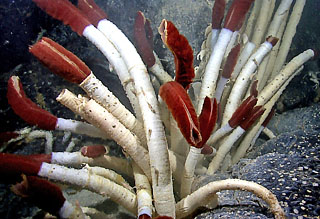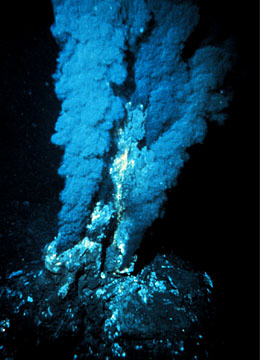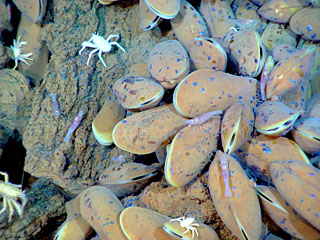Deep Sea Hydrothermal Vents

Giant Tube Worms Near a
Deep Sea Hydrothermal Vent
(NOAA Public Domain Image)
In the late 1970's, scientists on a routine study of the ocean floor in the Pacific made a discovery that would rock the entire scientific community. On the East Pacific Rise not far from the Galapagos Islands, nearly 8000 feet below the surface, was a strange alien landscape littered with what looked like chimneys expelling clouds of black smoke. Surrounding these chimneys was a unique type of ecosystem that had never been seen before. Until this day, science had always assumed that all life on Earth obtained its energy from the Sun. The plants convert sunlight into energy through a process called photosynthesis. The plants, in turn, provide food for countless species of animals in a complex web of life. But here, facing the deep-sea submersibles, was a sight that challenged those assumptions. Here was proof for the first time that life could be sustained by the Earth itself.

Black Smoker on the ocean floor
(NOAA Public Domain Image)
Science had discovered deep-sea hydrothermal vents. These vents occur in geologically active regions of the ocean floor. Within these regions, seawater seeps down deep into the Earth's crust through cracks and fissures in the ocean floor. This water is then heated by magma below the surface. As the water is heated to a boil, it expands and rises back to the surface. On it's way back up through the cracks and fissures through which it fell, the hot water dissolves minerals and other chemicals from the rock. When it reaches the ocean floor, the water is a dark, chemical soup. Some of the minerals precipitate out of the seawater and harden on the rim of the vent. Over time, the rim of the vent is built up into a tall, chimney-like structure. The dark color of the water spewing forth from these vents has earned them the name, "black smokers". The temperature of the water coming out of these vents exceeds 360º. The real surprise was the discovery that a myriad of life forms actually live and thrive around these vents, totally cut off from the world of sunlight.

Clams and crustaceans near a hydrothermal vent
(NOAA Public Domain Image)
Incredible deep-sea creatures have been known for quite some time. But these animals all depended on the regions above for their sustenance. They feed on small scraps of food and dead animals that fall from above. Here at the vents, though, something entirely different was taking place. These organisms were getting their food directly from the vents themselves. This process is known as chemosynthesis. Bacteria in the water actually feed on what would otherwise be a lethal soup of noxious chemicals. Smaller animals feed on these bacteria, and these smaller animals provide food for the larger animals. It is an entire ecosystem totally separate from the world of light. A large number of strange and wondrous creatures have been found at these vent sites. Giant tube worms eight feet tall dominate the landscape. Tiny bacteria living inside make food for the worms. Small shrimps and crabs feed on the tube worms. Clams cover the ocean floor. These waters are so fertile that shrimps have been known to literally number in the millions near these vents.
Deep Sea
Creature Database
'



